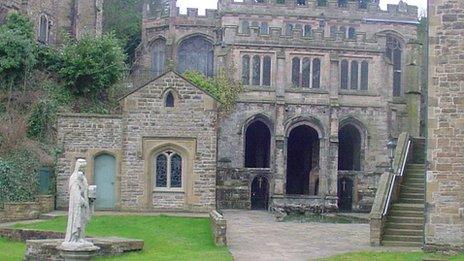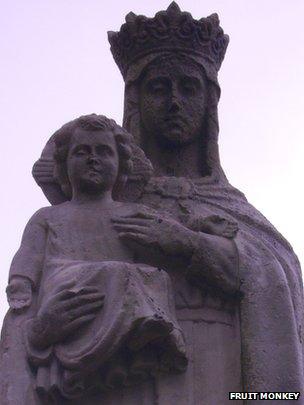Religious tourism on the rise, says Church in Wales
- Published

The buildings at St Winefride's Holy Well, Holywell, date to the 1400s
Religious tourism is on the increase with a growing number of people visiting historic places, according to the Church in Wales.
Although only anecdotal evidence is available, church leaders say there is a renewed interest in holy sites.
St Winefride's Holy Well in Flintshire reports a rise of about 6,000 visitors to 36,000 in recent years.
And one Denbighshire village group has been set up to restore a holy well which continues to receive visitors.
The Welsh government said tourism figures from 2011 show of 19% of UK staying tourists whose main reason for visiting Wales was to see specific places, also visited a place of worship during their stay.
Meanwhile, one spiritual group says it is organising its first trip to sacred sites in north Wales this summer as part of a retreat.
Custodians at St Winefride's Holy Well said they see people of all "creeds and denominations" who visit with an interest in the building's heritage or for religious purposes.
They point out that since the 1990s the number of visitors has risen from about 30,000 to 36,000 a year in 2011.
Nuns from the Order of the Most Holy Saviour of Saint Bridget even opened a guest house in 2008 to accommodate pilgrims and visitors to the well.
'Buoyant market'
Gladstone Library in Hawarden, Flintshire, which is a centre for the study of theology, also reports a small rise in people booking in to its residential accommodation, with a spokeswoman saying "religious tourism has remained a buoyant market for us".

Statue to "Our Lady" at Penrhys, Rhondda
The statue of the Lady of Penrhys overlooking the Rhondda Valley in south Wales is also said to be a big attraction along with the holy well which is regarded as the oldest recorded Christian site in the Rhondda.
In north Wales, staff at St Beuno's Ignatian Spirituality Centre in Tremerchion, Denbighshire, say they have seen a rise in the number of people who do not belong to any particular church or faith attending spiritual retreats.
"They have things in their life to sort out," said David Birchall, director at St Beuno's.
"They have a spiritual need but do not want to join churches."
In September the centre is hosting a retreat for people to visit places long regarded as sacred, including the holy well of St Dyfnog in the village of Llanrhaeadr, Denbighshire.
St Dyfnog, one of the Celtic saints, is the patron saint of the parish and went to live in Llanrhaeadr in the 6th Century.
Over the years, people made pilgrimages to the well as the waters are said to be renowned for their curative power.
A village committee was set up earlier this year to restore the well after receiving funding from rural development agency Cadwyn Clwyd to survey the site.
'On our doorstep'
Elsewhere, the Church of Wales's <link> <caption>Monmouth Diocese has made 2012 the year of pilgrimage</caption> <url href="http://www.churchinwales.org.uk/monmouth/DiocCMS/index.php/pilgrims/news" platform="highweb"/> </link> with a number of events to religious places such as St David's in Pembrokeshire along its Saints and Stones trail as well as to Rome.
However, Bishop of Monmouth, Dominic Walker, said there is a distinction between religious tourism and pilgrimage.
"Pilgrimage is when Christians set out on a journey to visit a place associated with a saint or holy event in order to deepen their relationship with God.
"Religious tourism is when people who, may or may not be Christians, go on holiday or on a day trip to visit churches or shrines because they are primarily interested in history or architecture but in so doing may learn something of the Christian tradition and the Christian faith.
"Churches should welcome both pilgrims and religious tourists and provide them with hospitality and whatever else may make their visits more enjoyable," he said.
St Asaph Diocese is making <link> <caption>2013 the year of pilgrimage</caption> <url href="http://www.churchinwales.org.uk/asaph/life/yearofpilgrimage/" platform="highweb"/> </link> , "forging further links with holy places and helping to promote religious tourism in north Wales".
The announcement comes a year after the opening of the <link> <caption>North Wales Pilgrim's Way</caption> <url href="http://www.bbc.co.uk/news/uk-wales-north-west-wales-14570952" platform="highweb"/> </link> which has "continued interest in religious tourism" in the diocese, according to organisers.
The path starts at Basingwerk Abbey in Greenfield, Flintshire, and links to a pilgrim route on the Lleyn peninsula, ending at nearby Bardsey Island.
Called the "island of 20,000 saints" after those reputed to be buried there, Bardsey has been an important pilgrim place for centuries.
But local communities also have important places on their doorsteps, according to Venerable Shirley Griffiths, Archdeacon of Wrexham, who is chair of St Asaph Diocese's working group which is organising the Year of Pilgrimage in 2013.
"It will also be an opportunity for us to highlight the many holy sites we are privileged to have on our doorstep and we hope to inspire others to discover this rich Christian heritage," she said.
Last year, Venerable Andrew Jones, the Archdeacon of Meirionnydd, wrote a book, Pilgrimage: the journey to remembering our story.
He believes pilgrimage or visiting places of religious interest "helps to tell us who we are, where we have come from and where we are going".
- Published18 August 2011
- Published8 October 2011